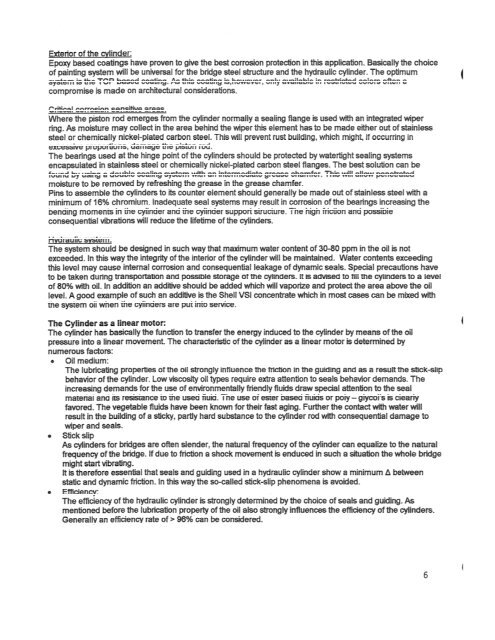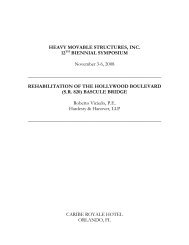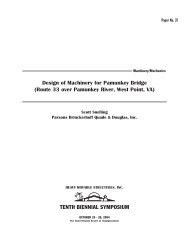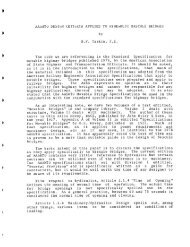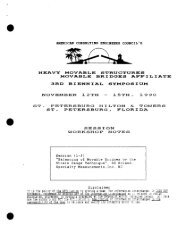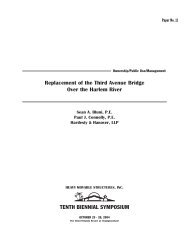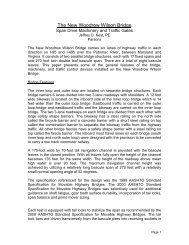Safety in Hydraulic Cylinder Lifting Systems - Heavy Movable ...
Safety in Hydraulic Cylinder Lifting Systems - Heavy Movable ...
Safety in Hydraulic Cylinder Lifting Systems - Heavy Movable ...
You also want an ePaper? Increase the reach of your titles
YUMPU automatically turns print PDFs into web optimized ePapers that Google loves.
Ederior of the cfl<strong>in</strong>der:<br />
Epoxy based coa@rsgs have proven to give the best c ~~~odon protedon <strong>in</strong> this applim%on. Bagwily the choice<br />
of pah%ng system klf be unbersal for the bhdge steel structure and the hydraulic N<strong>in</strong>der. The op%mum<br />
system is the TCP based coa'hg. As this coat<strong>in</strong>g is,'nowewer, only available <strong>in</strong> restricted colors often a<br />
compromise is made on archtectuwl considera%ons.<br />
CMca8 corrosion sensitbe areas.<br />
Where the pisdon rod emerges from We cyl<strong>in</strong>der normaily a seal<strong>in</strong>g flange is used with an <strong>in</strong>tegrsted wiper<br />
r<strong>in</strong>g. As moisture may coljed <strong>in</strong> %e area beh<strong>in</strong>d the wiper this element has to be made either out of sta<strong>in</strong>jess<br />
steel or chemically nickel-plated carbon steel. This will prevent rust build<strong>in</strong>g, which might, if occurr<strong>in</strong>g <strong>in</strong><br />
excesske propomons, damage the pjston rod.<br />
The bear<strong>in</strong>gs used at the h<strong>in</strong>ge po<strong>in</strong>t of the cyl<strong>in</strong>ders should be padected by wa8~gh"s sear<strong>in</strong>g systems<br />
encapsulated <strong>in</strong> sta<strong>in</strong>less steel or chemimlly nickel-plated carbon steel Ranges. The best solu%on can be<br />
found by us<strong>in</strong>g a double seal<strong>in</strong>g system -with an <strong>in</strong>termedisate grease chamfer. This wi!& a89ow pene&ated<br />
moishrre to be remow& by reeesh<strong>in</strong>g the grease <strong>in</strong> the grease chamfer.<br />
P<strong>in</strong>s to assemble the cyl<strong>in</strong>dees to its counter element should generally be made out of stsh8ess steel &h a<br />
m<strong>in</strong>imum of 16% chromium. <strong>in</strong>adequate seal systems may result <strong>in</strong> corrosion of the bear<strong>in</strong>gs <strong>in</strong>creas<strong>in</strong>g the<br />
bend<strong>in</strong>g momenb <strong>in</strong> the cyl<strong>in</strong>der and the cyl<strong>in</strong>der support skudure. The high fricgon and posibte<br />
consequen@al abra@ons will reduce the lifeeime of the cyi<strong>in</strong>ders.<br />
Hvdrauiic svs8em:<br />
The system should be designed <strong>in</strong> such way that maximum water content of 30-80 ppm <strong>in</strong> the oil is not<br />
exceeded. In this way the <strong>in</strong>tegw of the <strong>in</strong>terior ofthe cyi<strong>in</strong>der wiII be ma<strong>in</strong>ta<strong>in</strong>d. Water contents exceed<strong>in</strong>g<br />
this level may cause <strong>in</strong>ternal corrosion and consequenaal leakage of dynamic seals. Special precau%ons have<br />
to be taken duGng %ranspoda%ion and possible &orage ofthe cyl<strong>in</strong>des. 8% b advised to 5Ii the cyl<strong>in</strong>ders to a level<br />
of 880% with oil. In add~on an addj&e $hoglid be added Aich wiAlil! vaporize and prated the area above the oil<br />
Ievef. A good example of such an ad&de k the SheQl VSI conenbate Wick <strong>in</strong> most cases ma be mixed &h<br />
the system oil when the cyl<strong>in</strong>ders are put <strong>in</strong>to service.<br />
The Cyt<strong>in</strong>der as a l<strong>in</strong>ear motor:<br />
The qt<strong>in</strong>der has himliy the funceona 40 transfer the energy <strong>in</strong>duced to the cyl<strong>in</strong>der by means of the oil<br />
pressure <strong>in</strong>to a l<strong>in</strong>ear movement, The chawcteriseic of the wi<strong>in</strong>der as a l<strong>in</strong>ear motor is defterm<strong>in</strong>ed by<br />
numerous factors:<br />
e oi! medium:<br />
The lubGcag<strong>in</strong>g propaes of the oil s&ongly <strong>in</strong>fluence %he Mc%on <strong>in</strong> the gu~<strong>in</strong>g and as a resea8 the sack-slip<br />
behaior of Be ql<strong>in</strong>der. tow viscosity oil types require extra aatengon to seals behaPljor demands. The<br />
<strong>in</strong>creas<strong>in</strong>g demands for the use 03 endronmentally faenday fluids draw special a%en@on to the seal<br />
mab~a8 and b resist;ance to the used fluid. The use of ester based fluids or ply - glycol's is deady<br />
kvored. The vegdabie 3uids have been known for Uaeir fa& ag<strong>in</strong>g. Further he con&@ mter &.iOI<br />
result <strong>in</strong> the buiid<strong>in</strong>g of a sticky, pady hard substance to the cyi<strong>in</strong>der rod d h mwswuential damage to<br />
vbriper and seais.<br />
Stick slip<br />
As cyliraders for bridgs are often slender, the natural frquenq of the wi<strong>in</strong>der can equalize to the nawral<br />
frequency ofthe bidge. if due to faiajon a shock movement is enduwd <strong>in</strong> such a s%ua%on the whole bridge<br />
migM start vibaatng.<br />
B"r therefore essential %at seals and guid<strong>in</strong>g used <strong>in</strong> a hydraulic cyi<strong>in</strong>der show a m<strong>in</strong>imum d beheen<br />
static and dynamic ficgon. In this way the so-called stick-slip phenomena is moided.<br />
B IEtFliiciency:<br />
The edficiency ofthe hydmdc cyl<strong>in</strong>der k strongty determ<strong>in</strong>ed by the choice of seals and guidi<strong>in</strong>g. As<br />
mention4 before the lubrication propem of the oil also *ong!y <strong>in</strong>fluences the emoiency of me cqriiwdess.<br />
Generally an e%cienq rate of > 96% can be mnsidered.


